Understanding Cruiser Board Trucks and Wheels
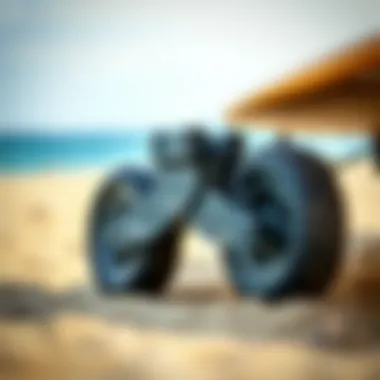
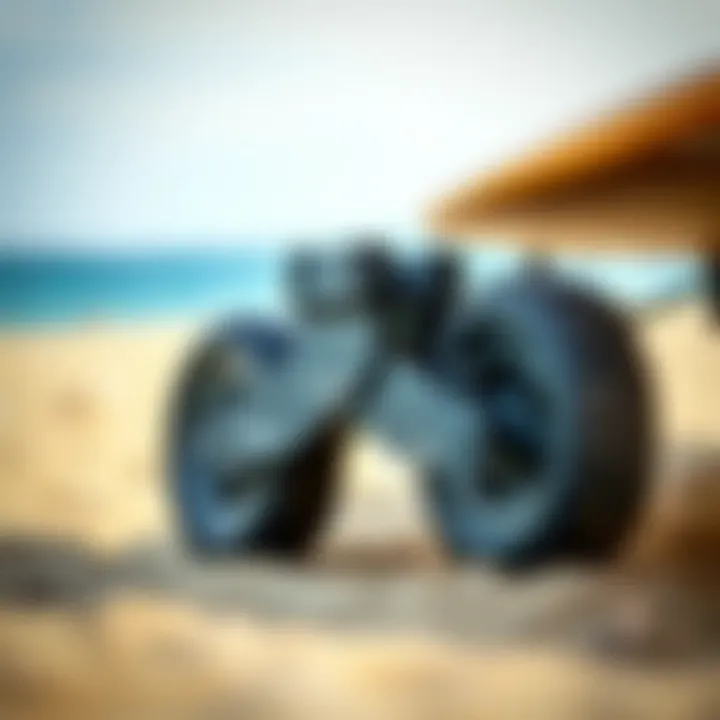
Intro
When it comes to skateboarding, many folks find themselves drawn to the free-spirited vibe of cruisers. Unlike trick boards set up for flips and spins, cruiser boards tend to spread their wings in style and comfort. Central to their performance are the trucks and wheels. These two components might seem mundane, but they're the heart and soul of how your board rides. Whether you’re weaving through a bustling boardwalk or gliding down quiet streets, the right setup can dramatically change your experience.
Understanding the world of cruiser board trucks and wheels isn't just for the seasoned skater. Newcomers can also gain from a solid foundation. In a way, it’s like learning the ropes to any new hobby; knowledge empowers you to make informed choices. From the types of trucks available to how wheel size affects your glide, this article will explore every nook and cranny of the subject.
Get ready to roll, as we jump into the many facets that shape your boarding experience.
Gear Essentials
Your cruiser board setup consists of various elements; among them, the trucks and wheels are arguably the most critical. Choosing the right gear not only enhances your performance but also affects your overall style. Let’s dive deeper into these essentials.
Understanding Cruiser Trucks
Trucks are the metal components that hold the wheels in place. They affect how your board turns and handles different terrains.
- Material: Most trucks are made from aluminum for its blend of lightweight properties and durability. However, some models utilize steel or composite materials for various performance benefits.
- Height: Trucks also come in different heights. Low trucks offer more stability for cruising and tricks, while high trucks enable larger wheels, which provide better absorption of bumps.
Choosing the Right Wheels
When it comes to cruiser wheels, the size and durometer (hardness rating) play significant roles.
- Size: Generally, larger wheels (55mm and above) roll over imperfections in the pavement, providing a smoother ride. Smaller wheels make for a more responsive board, more suited to tricks than the leisurely ambiance of cruising.
- Durometer: Softer wheels (78A to 87A) offer better grip and shock absorption, making them ideal for rough surfaces. Harder wheels (88A and above) provide speed but can be skittish over bumps.
"The right wheels make all the difference in how a board rides; picking the wrong set can lead to a bumpy experience that takes the joy right out of skating."
Maintenance and Care Tips for Gear
Once you've chosen your gear, proper maintenance is key to longevity and performance. Here are some tips:
- Regularly check your trucks: Ensure that the bolts are tight, and inspect for any signs of wear or fatigue.
- Clean your wheels: Over time, wheels accumulate dirt and grime, affecting ride quality. Use a damp cloth to wipe them down.
- Lubricate bearings: Keeping your wheel bearings well-lubricated minimizes friction and increases speed.
Maintaining your skates doesn't have to feel like a chore. A little care goes a long way in ensuring that your cruising experience remains top-notch.
In the next section, we'll explore techniques and tips to elevate your riding style, whether you're just getting the hang of things or looking to refine your skills.
Prelude to Cruiser Boards
In the evolving world of skateboarding, cruiser boards occupy a special niche. Unlike their trick-savvy counterparts, cruisers are designed for smooth rides, allowing enthusiasts to navigate both urban landscapes and coastal paths with ease. Their significance is not merely in being a mode of transport; they represent a lifestyle, reflecting the rider's desire for freedom and ease of movement.
Understanding cruiser boards is essential for anyone looking to enhance their skating experience. These boards come equipped with unique features that cater to different riding styles and preferences. Whether you are an emerging skater or an experienced rider, being well-versed in the anatomy of fin and functional elements can lead to a more pleasant cruising experience.
Definition and Purpose
A cruiser board is generally characterized by its compact size, wider wheels, and flexible construction. The primary purpose of a cruiser board is to facilitate comfortable cruising rather than performing tricks or stunts. The wider wheels offer better grip and a smoother ride over various surfaces, allowing for an enjoyable experience for riders of all skill levels. Unlike traditional skateboards that may be focused on tricks, cruisers are about enjoying the ride, commuting, or simply having fun.
The design often incorporates a longer deck compared to a standard skateboard. This provides ample space for foot placement and stability while riding. With these characteristics, cruiser boards serve as a perfect bridge between skateboarding and walking, making it easier to hop off and on as needed.
History of Cruiser Boards
The history of cruiser boards traces back to the early days of skateboarding in the 1960s when surfers sought a way to replicate the sensation of riding waves on land. The initial designs were quite rudimentary, constructed from wood and equipped with metal wheels. Over time, materials and designs evolved, yet the core concept remained the same: a board that combines the thrill of riding with the practicality of transportation.
In the late 1970s and early 1980s, the skateboard scene exploded. During this time, the introduction of urethane wheels marked a significant shift. These wheels offered greater traction and durability, which made cruising not just practical but enjoyable. Over the years, cruiser boards continued to gain popularity, especially among those preferring casual rides over aggressive tricks.
As the skate culture grew, so did personalization and artistic expression in cruiser board design. Riders began to customize their boards, reflecting their unique personalities and preferences. Fast forward to today, and the market offers a mind-boggling variety of shapes, sizes, colors, and materials – all catering to an ever-growing audience of skating enthusiasts.
"True skaters feel more alive when cruising. It’s not just about getting from point A to point B; it’s about the journey."
As trends continue to shift and skateboard technology advances, cruiser boards remain a beloved choice for many. From their humble beginnings to the stunning varieties available now, understanding their history enriches your appreciation for the craft and the lifestyle associated with it.
Becoming acquainted with cruiser boards sets the stage for exploring their fundamental components: the trucks and wheels. Each of these parts plays a crucial role in defining how a cruiser board performs and feels.
Understanding Trucks
Diving into the realm of cruiser board trucks is akin to exploring the backbone of the skateboard itself. Trucks play a vital role in determining how a board behaves during a ride, impacting everything from turn radius to stability at higher speeds. For skaters, understanding the intricacies of trucks helps tailor their setups to fit personal riding styles. Let's break down what trucks are, their fundamental components, and why each part is critical to the overall cruising experience.
What Are Trucks?
At their core, skateboard trucks are metal axles attached to the underside of the board. They allow the wheels to spin freely and control the board's direction when turning, as well as managing how the board rides over various terrain. Think of trucks as the steering wheel of a car, providing the necessary guidance to navigate smoothly.
Several types of trucks exist, each designed to cater to different styles of skating. Some offer a tight turning radius for sharp maneuvers, while others provide extra stability for cruising at higher speeds. Ultimately, the right truck affects performance significantly, contributing to an enjoyable ride.
Components of Trucks
Understanding the components that make up a truck is essential to grasp its functionality better. Here’s a look at the four main parts and how they serve skaters.
Baseplate
The baseplate is the part of the truck that secures it to the skateboard deck. It's the foundation that holds everything together. A well-designed baseplate offers both strength and flexibility, which are crucial for a great ride. Some skaters prefer a wider baseplate for extra stability, especially when cruising. A notable feature to consider is the angle of the baseplate, which can affect turning capabilities. A steeper angle usually allows for sharper turns but might sacrifice some stability.
Factors to keep in mind:
- Material: Often constructed from aluminum, ensuring durability.
- Compatibility: A good baseplate fits well with various deck types.
- Weight: Lighter materials can enhance maneuverability but may not have the durability of heavier options.
Hanger
The hanger is the elongated part of the truck that connects the baseplate to the axle. It is responsible for pivoting during turns, greatly affecting how the board responds to rider input. A wider hanger provides better stability and better weight distribution.
However, a narrower hanger allows for quicker turn initiation. A key characteristic to note is its design which can impact the overall ride feel, giving a balance between stability and agility based on skater preference.
- Flexibility: Hangars with more give aid in smoother rides on uneven surfaces.
- Material: Just like the baseplate, hangers are mostly made from aluminum for optimal performance.
Kingpin
The kingpin holds the truck components together, acting as the pivot point when turning. The quality of the kingpin can affect how the truck responds to weight shifting during riding. A strong kingpin typically allows for tighter turns without compromising durability.
Specifications to consider:
- Size: A longer kingpin can provide more turning leverage but may be more susceptible to bending.
- Tightening: Adjustable kingpins let skaters customize their ride, from loose for tricks to tight for speed rides.
Bushing
Bushings are the rubber parts located above and below the hanger. They cushion the turns and absorb shock when hitting bumps or curbs. The type and hardness of bushings play a significant role in how the board feels. Softer bushings provide more flex for easier turning, while stiffer ones offer more stability at high speeds.
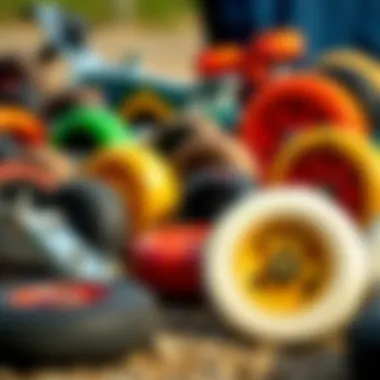
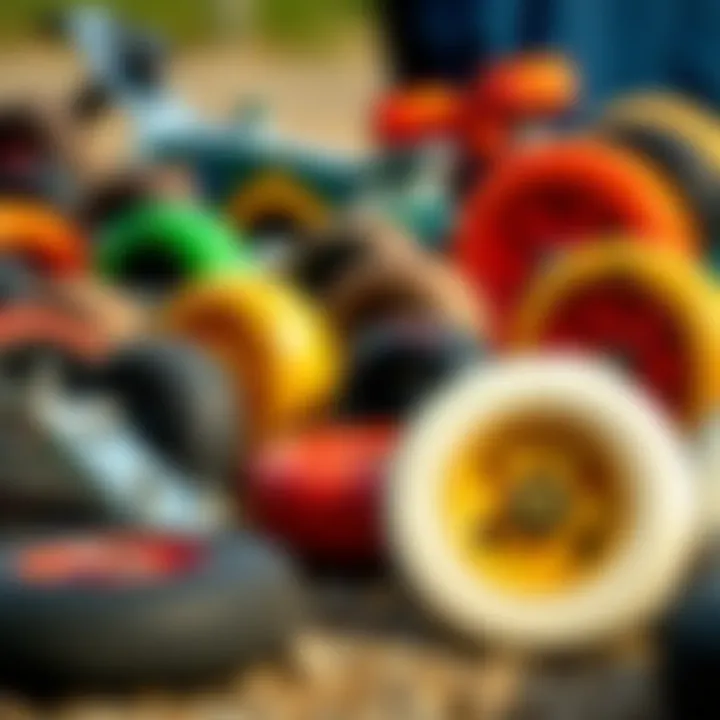
Some notes on bushings:
- Durometer: Measured in shore hardness, a lower number indicates softer, more pliable bushings which are easier to turn.
- Shape: Different shapes can enhance the feel of certain movements, with some designed specifically for trick performance.
In summary, understanding the role each component plays in skateboard trucks can help you make informed decisions. Each part has its unique characteristics and advantages, shaping the overall cruising experience. The better you know your setup, the more you can fine-tune it to match your personal skating style.
"The right truck setup can turn an average ride into an extraordinary experience."
For further insights about trucks and their components, you can explore resources like Wikipedia or Britannica for comprehensive coverage.
Weight and Size Considerations
When it comes to cruiser boards, the weight and size of the trucks can’t be brushed aside. These specific elements play a crucial role in determining the handling, stability, and overall riding feel of the board. It’s not just numbers on a scale; it’s about how those numbers translate into physical experience and performance on the street or the boardwalk. Balancing these factors correctly can greatly enhance your riding experience, turning a good ride into a phenomenal one.
Truck Width
Truck width essentially refers to the distance between the inner edges of the truck hangers. This measurement influences the board's stability and responsiveness. A wider truck allows for greater stability, especially during turns or at higher speeds. If you’re cruising through tight corners at full tilt, having a wide truck can be the difference between a smooth glide and an unintended tumble.
Selecting the appropriate width also keeps your wheel's alignment in check, which is crucial for ensuring smoother rides and reduced tire wear. Here are some essential takeaways:
- Compatibility: Ensure that the truck width corresponds to your board’s width for optimal performance. For instance, a board that's eight inches wide typically works best with trucks that measure around 5.0 to 5.5 inches.
- Riding Style: Taller walls or bowls might call for wider trucks to keep everything steady, whereas street skating might benefit from a more narrow design, allowing for better agility.
- Personal Preference: Ultimately, the decision can come down to how it feels underfoot. Some riders prefer the rigidity of wider trucks, while others might enjoy the flick of a narrower setup.
Truck Height
Another vital aspect is truck height. Typically categorized as low, mid, or high, the height directly affects your board's center of gravity and how it interacts with the surface beneath it. Here’s the lowdown:
- Low Trucks: As their name suggests, low trucks sit closer to the board. They offer improved stability for tricks and can lower your center of gravity, which is a boon for technical maneuvers. However, low trucks limit wheel size, often causing wheel bite—the pesky situation where your wheels make contact with the board during tight turns.
- Mid Trucks: This is somewhat of a sweet spot. Mid height trucks strike a balance — they allow for maneuverability while providing stability without the fear of wheel bite. They’re the go-to for riders who enjoy varied terrains.
- High Trucks: Meanwhile, high trucks give you the advantage of larger wheels and enable easier clearance for rough terrain. They can be especially helpful for rides on uneven surfaces, but they might feel less stable during quick turns or at high speeds.
Understanding how truck dimensions—and their interplay with weight—affect your ride is paramount. Each rider might have a different comfort zone, but knowing the fundamentals allows you to tailor your setup to fit your needs. If you’re beginning to feel lost in the weeds, fear not! There is a wide array of resources and community forums where skaters exchange their insights, such as Reddit, or you can consult guides from manufacturers like Santa Cruz Skateboards.
"In skating, just like in life, it’s all about finding your balance."
Navigating the world of cruiser board setups may seem overwhelming at times, but taking these weight and size considerations into account will set you on the right path. Understanding how the width and height of your trucks interact not only with your board but also with your unique riding style will undoubtly make for a more enjoyable experience.
Types of Trucks
When we pick up a cruiser board, the choice of trucks is what often separates a satisfying ride from one that feels like paddling through molasses. The types of trucks available set the foundation for your experience, influencing your board's handling, stability, and glide. It’s crucial to dive into this subject to understand how each type impacts performance and what riding style suits you best.
Standard Trucks
Standard trucks are like the bread-and-butter of the skateboarding world. They're the most common type used across all kinds of boards and offer a balanced ride. These trucks typically come in one size and form, making them a reliable choice for beginners to seasoned pros. The design usually consists of a hanger that sits atop the baseplate, allowing for a responsive and smooth turn.
A key benefit of standard trucks is their versatility. They can handle a range of terrain, from cruising on smooth pavements to tackling the occasional rough patch. However, they may not always provide the exact performance required for specialized activities like tricks or downhill riding. When considering standard trucks, think about what you'll be doing—if cruising is your primary goal, these trucks will do just fine. They often come in various widths to match your board's size, ensuring compatibility.
Drop-Through Trucks
Drop-through trucks take the cake for those who seek a lower center of gravity and a more stable ride. Designed with a unique setup where the baseplate is mounted through the deck, these trucks allow the board to sit lower to the ground. This design noticeably enhances stability, making it an excellent option for cruising long distances or downhill runs.
One of the significant upsides of drop-through trucks is the ease of pushing. If you find yourself frequently pushing off to gain speed, the lower height can increase efficiency and reduce fatigue. However, a word to the wise: while these trucks provide stability, they might limit certain trick options due to the compromise in height. Ensuring you match these trucks with the right wheels is essential, as larger wheels may create wheel-bite issues.
Reverse Kingpin Trucks
Stepping up our discussion, reverse kingpin trucks are a favorite among those who fancy agility and a dynamic riding experience. The kingpin—a crucial component in truck design—is positioned in the reverse direction compared to traditional setups. This configuration allows for sharper turns and smoother transitions, resulting in a lively riding experience.
These trucks shine when it comes to tricks and park riding, where their responsiveness adds to the fun factor. However, it’s important to keep in mind that with all that agility can come a lack of stability at high speeds. That being said, whether you’re carving through an empty park or venturing into a bustling urban landscape, reverse kingpin trucks can be a great asset for those who embrace an adventurous cruising style.
“Choosing the right truck can be the difference between a ride that sings and one that lags behind.”
Wheels: The Key to a Smooth Ride
When it comes to cruising, wheels are much more than mere rubber circles. They’re fundamentally linked to the overall experience a skater has. The right wheels can transform a bumpy ride on an uneven street into a seamlessly smooth glide, making them a critical factor in the performance of a cruiser board. Whether you’re navigating city sidewalks or carving through park paths, understanding wheels will dramatically enhance your skating adventures.
Wheels Basics
Wheels come in various sizes, shapes, and materials, each contributing to how a board handles and feels. Most commonly, wheels vary in diameter. Generally, the diameter ranges from 50 mm to over 70 mm. Larger wheels provide a smoother ride and are better suited for rough terrains, while smaller wheels allow for quicker turns and tricks, fitting neatly into the preferences of every skater’s style.
The shape of the wheel also plays a vital role. Some wheels feature a square edge, which provides better grip, while others have a more rounded edge, facilitating smoother slides. Additionally, wheels are typically made from urethane, which allows flexibility and durability, giving skaters a reliable vessel for their cruising journeys.
It’s also worth noting that wheel color and design are often chosen for aesthetic appeal, but they can influence visibility and style on the streets, adding to the rider’s personal flair.
Hardness and Durometer
Wheels vary significantly in hardness, measured by a scale called durometer. Typically, the hardness of skateboard wheels is shown as a number followed by the letter 'A', such as 78A or 101A. Softer wheels, around 78A-87A, provide better traction on uneven surfaces while absorbing shock, but they wear down more quickly. For a casual rider who enjoys cruising leisurely around the neighborhood or tackling rough paths, softer wheels are often a preferred choice.
On the other hand, harder wheels, generally over 88A, offer increased speed and grip on smoother surfaces, but they may not absorb bumps as effectively, leading to a harsher ride. If a skater primarily plans on cruising in a park or on well-maintained streets, they might opt for something in the harder range.
"Understanding your wheel hardness is critical; it's the fine line between enjoying your ride and feeling the every bump."
Skaters must balance these factors to choose wheels that align with their style and cruising needs. Factors such as terrain, riding style, and personal preferences should influence the choice of tire hardness. Exploring these options can lead to a more tailored riding experience that makes every trip rewarding.
Wheel Size and Its Impact
The size of wheels on cruiser boards is crucial, influencing factors such as ease of riding, speed, and the overall feel of the board. In the context of cruising, the right wheel size can mean the difference between gliding smoothly over pavement cracks and feeling every bump along the way. Understanding wheel size helps skaters make informed decisions that align with their riding styles and preferences.
Small Wheels
Small wheels usually range from 50mm to 54mm in diameter. They are great for technical tricks and street skating. However, when it comes to cruising, their advantages shift. With small wheels, you get an immediate sense of responsiveness, allowing for sharp turns and quick maneuvers. That said, they can struggle to maintain speed on rough surfaces. A rider who opts for small wheels might find themselves needing to kick harder to keep up momentum, especially when transitioning from a smooth street to a bumpy sidewalk.
Pros:
- Increased control for tricks and agility in urban landscapes.
- Lightweight, which adds to the board's overall responsiveness.
Cons:
- Not ideal for rough terrain; small wheels may absorb less shock, impacting comfort.
- Limited glide, requiring more effort to maintain speed over distances.
Medium Wheels
Medium wheels typically fall between 55mm and 60mm in size. This size strikes a balance between maneuverability and versatility. Riders often choose medium wheels for an all-rounded experience. They offer more cushion than small wheels, helping to smooth out bumps while still aiding in sharp turns when needed. Medium wheels appeal to those who ride in varying terrains, allowing for enough speed to cruise yet retaining the ability to perform tricks.
Pros:
- Versatile; can handle both cruising and some trick performance.
- Better impact absorption, providing a smoother ride over rough surfaces.
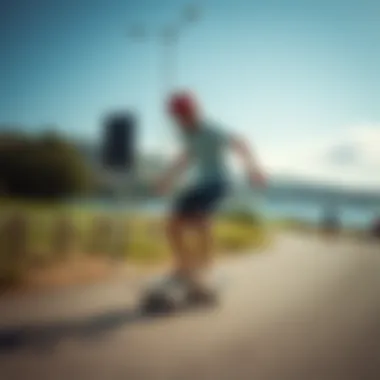

Cons:
- May not provide the same level of control as small wheels for precise technical tricks.
- Riders looking for top speed might find them slightly limiting compared to larger wheels.
Large Wheels
Large wheels, usually measuring over 60mm, shine when it comes to cruising. Their larger diameter allows for a more stable ride and better shock absorption, making them excellent for rough roads or uneven surfaces. While this size is not typically favored for quick tricks, the benefits for cruising are undeniable. Large wheels provide a smoother experience, allowing for gliding over imperfections in the pavement without sacrificing speed. Riders who prefer long distances or simply enjoy a leisurely ride often gravitate towards larger options.
Pros:
- Superior glide and speed on all kinds of terrains.
- Great shock absorption, enhancing comfort and reducing fatigue during longer rides.
Cons:
- Less maneuverable for quick turns or technical tricks.
- Heavier than smaller wheels, possibly impacting some riders' preferences for responsiveness.
In essence, the choice of wheel size ultimately ties back to personal riding style and the types of surfaces one expects to traverse. Understanding these nuances allows skaters to tailor their setup for the best possible riding experience.
Materials Used in Trucks and Wheels
When it comes to cruiser boards, the materials used in the construction of trucks and wheels can greatly influence performance, ride quality, and durability. Selecting the right materials is not just a matter of preference; it’s about understanding how each material impacts your skating experience. Knowing the strengths and weaknesses of what makes your skateboard tick can lead to a more enjoyable ride. In this section, we’ll explore three major materials commonly used in cruiser board components: aluminum, plastics and composites, and urethane.
Aluminum
Aluminum is the undisputed champion when it comes to the trucks of cruiser boards. Its light weight and high strength make it a popular choice among skateboarders of all levels.
- Durability: Aluminum trucks can withstand considerable wear and tear. Unlike plastic, they don’t crack easily under stress.
- Performance: The lightweight nature of aluminum helps in achieving increased maneuverability. For those who appreciate tight turns and responsiveness, aluminum trucks provide a distinctive edge.
- Heat Dissipation: A lesser-known benefit of aluminum is its ability to dissipate heat efficiently. When trucks are used intensively, they can become quite warm. Aluminum helps manage this heat, which in turn can affect performance and longevity.
However, one needs to be cautious about the potential for corrosion, especially if you’re skating in wet conditions. Keeping an eye on the condition of your trucks is essential.
Plastic and Composites
Plastic and composite materials have made a name for themselves in the skateboard world, offering an alternative to traditional metals.
- Weight Reduction: For skaters who prioritize lightweight setups, composite trucks can vastly reduce weight. This can be particularly beneficial for tricks where every ounce counts.
- Flexibility: Composites can offer a different flex experience compared to metallic counterparts. Some skaters enjoy the way a composite truck can provide a unique feel, offering flexibility that translates into enhanced pop.
- Cost-Effective: They are often less expensive than aluminum trucks, making them appealing for entry-level skaters or those not ready to make a hefty investment.
Nonetheless, the durability of plastic trucks may be a concern for some. Extreme and aggressive use may lead to faster degradation compared to aluminum. They are often best suited for relaxed cruising rather than high-energy tricks.
Urethane
When we speak of wheels, urethane steals the spotlight. It’s the go-to material for crafting quality skateboard wheels due to its myriad of benefits.
- Smooth Ride: Urethane wheels provide an exceptional grip and a smooth ride, even on uneven surfaces. The material absorbs shocks from rough terrain, making for a more comfortable cruising experience.
- Longevity: Compared to softer rubber wheels, urethane is known for its resistance to wear and tear. Skaters can expect a good lifespan out of their urethane wheels, which is an absolute plus for frequent riders.
- Versatility: Urethane wheels can be found in various hardness levels, catering to different riding styles. Whether you prefer a soft, grippy feel or a harder, faster ride, there’s a urethane wheel suitable for your preferences.
However, some skaters might feel that urethane, while resilient, can sometimes provide less grip in wet conditions. Picking the right type of urethane wheels involves considering where and how often you plan on skating.
Understanding these materials is essential for anyone looking to elevate their riding game. Insights into materials can pave the way for smarter and more informed decisions.
Choosing the Right Setup for Your Cruiser Board
Choosing the right setup for your cruiser board is a pivotal aspect that can greatly influence your overall skating experience. With various elements in play, including the selection of trucks and wheels, having the right configuration is not just about aesthetics; it’s about performance, comfort, and ensuring that your ride matches your personal style. The setup process allows you to tailor your skateboard to your specific preferences, optimizing factors such as maneuverability, ride smoothness, and stability.
A well-thought-out setup can mean the difference between a bland and cumbersome ride and one that feels like an extension of yourself. This customizing process not only enhances enjoyment but also reflects your personality and skating style. The key here is understanding the interplay between your chosen components and how they each contribute to your cruising dynamics.
Consider Your Riding Style
Your riding style is a cornerstone for determining the ideal setup for your cruiser board. It’s like finding the right pair of shoes—the wrong fit can lead to discomfort and hinder your performance. For instance, if you favor relaxed, laid-back rides through city streets, you might prioritize wider trucks for stability and softer wheels for a smooth glide over uneven surfaces. Alternatively, if you prefer carving through turns and showcasing tricks, a narrower truck and harder wheels might serve you better, allowing for sharp turns and quicker responsiveness.
Think about how you like to ride:
- Do you cruise along the boardwalk, enjoying the scenery?
- Are you looking to perform tricks and take on ramps?
- Perhaps you commute through bustling city streets?
Identifying your primary use is crucial. A versatile setup can accommodate different styles, but having a clear idea of your dominant preferences narrows down the myriad options available. As you consider your riding style, it’s helpful to engage with the skating community. Forums like reddit.com/r/skateboarding offer real insights from experienced skaters, and you can glean valuable knowledge about setups that work best across different riding styles.
Setting a Budget
Establishing a budget is an essential step in the process of choosing your cruiser board setup. While it’s tempting to go all out and splurge on high-end gear, you should strike a balance between quality and affordability. Investing in quality trucks and wheels is wise, as lower-quality items can wear down quickly, leading to a grumpy ride and potential safety risks.
Consider the following when setting your budget:
- Materials: Higher quality materials like aluminum for trucks often lead to enhanced durability but can be pricier.
- Brand Reputation: Well-known brands may charge more due to their proven track records. However, less familiar brands can offer surprisingly good value.
- Purchase Timing: Look out for sales during off-seasons or holiday promotions, where prices might drop significantly.
It’s crucial to remember that your initial investment could save you money in the long run—trying to shave costs in the wrong area can lead to replacements sooner than later. As you lay out what you are willing to spend, it assists in filtering choices when selecting trucks and wheels without getting overwhelmed.
In essence, both understanding your riding style and establishing a budget are key pillars in arranging the perfect cruiser board setup. Engaged with this knowledge, you're in a better position to explore the vast landscape of skating gear, making informed decisions that result in an enjoyable and personalized riding experience.
Installation and Maintenance
When it comes to getting the most out of your cruiser board, installation and maintenance are two key areas that should never be overlooked. Proper setup of trucks and wheels contributes not just to performance but also to riding safety and comfort. After all, what’s a smooth ride if your board is not properly assembled or maintained?
Parts Assembly
Installing the trucks and wheels on your board might sound straightforward, but it involves a careful process. The first step is ensuring that you have the right tools at hand—typically a skateboard tool, which can tighten the axle nuts, and a Phillips screwdriver for securing the baseplate to the deck. Begin by placing the trucks upside down on a flat surface to check for any wear or damage before assembly.
Next, position the baseplate over the drilled holes on your board’s deck, aligning it correctly. Use the screws provided with your trucks to secure the baseplate, tightening them so it doesn’t wiggle but also being cautious not to strip the screws.
After the trucks are firmly attached, it’s time to install the wheels. Slide them onto the axles and tighten the nuts by hand just until they feel snug. You want them to spin freely—if too tight, the wheels won’t roll well; too loose, and they’ll rattle around, compromising performance.
Routine Maintenance Tips
Maintaining your cruiser board is essential for longevity. Just like any sport equipment, neglecting regular checks can lead to subpar performance or, worse, accidents. Here are some crucial maintenance tips:
- Check Wheel Tightness: Every few rides, make a habit of checking the tightness of your wheel nuts. If they become too loose, you risk losing wheels during a ride.
- Inspect Bushings: The bushings in your trucks are made of soft rubber, which can wear out over time. Regularly inspect them for cracks or excessive wear. If they are damaged, replace them to ensure smooth turns.
- Clean Your Board: Grit and grime can clog bearings, causing them to wear out prematurely. A simple wash with soap and water followed by a rinse can go a long way. Use a soft brush to make sure dirt is removed from hard-to-reach areas.
- Lubricate Bearings: Bearings require occasional lubrication for optimal performance. Apply bearing oil or grease to keep them running smoothly. Be careful not to over-lubricate, as that can attract dirt.
- Tighten Holes and Screws: Vibration and movement can cause screws to loosen over time. Regularly check and tighten all the screws on your trucks and wheels.
Taking the time to properly install your trucks and wheels, followed by regular maintenance, not only enhances your riding experience but also extends the life of your board. Keeping everything in check lets you focus on the road ahead.
"A well-maintained board is like a loyal friend; it responds well and supports you better."
For additional resources on maintenance techniques, check out the online guide on Wikihow or Bicycle Online for tips on caring for different materials like urethane or aluminum.
By making installation and maintenance a priority, you are investing in your cruising experience, allowing for more enjoyable and safe rides.
Comparative Analysis: Different Cruising Experiences
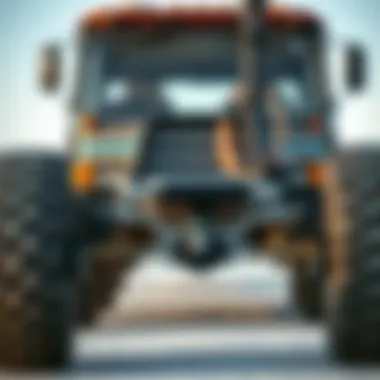
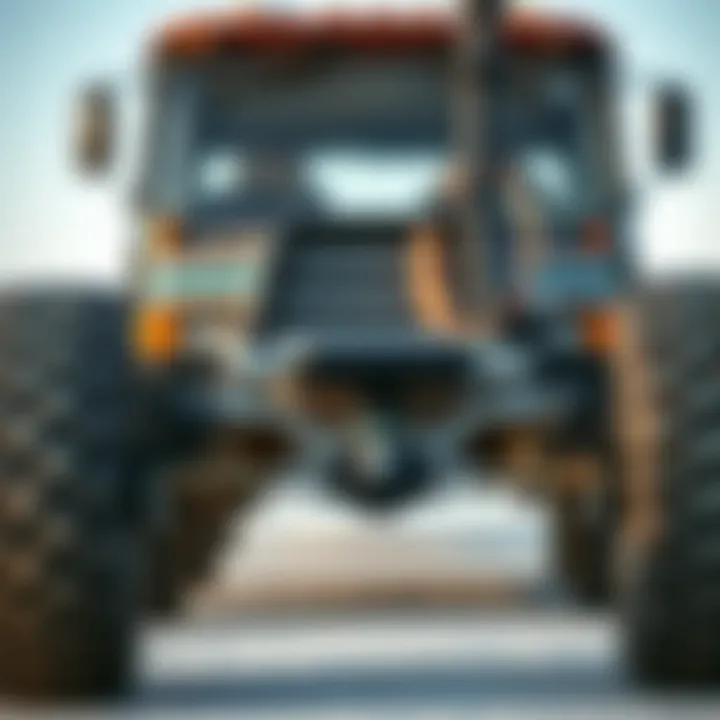
When it comes to riding a cruiser board, the experience varies from one individual to another. This section delves into the nuances of how different setups influence cruising experiences. Whether you are navigating city streets or gliding along coastal paths, the choice of trucks and wheels will significantly affect how your ride feels.
Performance Metrics
Performance metrics play a crucial role in understanding how well a board performs under various conditions. It's not just about speed; it encompasses stability, maneuverability, and comfort as well. Here are some key aspects that can aid your decision:
- Stability: Wide trucks usually provide more stability, especially at higher speeds. It's important for riders who want a smooth journey without constant adjustments.
- Maneuverability: This is where the type of truck makes a huge difference. For instance, reverse kingpin trucks tend to deliver better turn initiation than standard trucks, allowing for sharper and more responsive turns. This can be particularly crucial when navigating crowded areas or tight corners.
- Ride Quality: The combination of wheel hardness and size influences how the board absorbs shocks from uneven terrain. Softer and larger wheels absorb impacts better, ensuring a more forgiving ride.
- Speed: Wheel durometer is another metric to keep an eye on. Harder wheels can roll faster on smooth surfaces, while softer wheels provide grippier traction, particularly beneficial on rougher roads.
"Choosing the right combination of trucks and wheels can transform your cruising experience from ordinary to extraordinary."
User Experiences
Understanding user experiences allows us to see the practical implications of different setups. Feedback from fellow riders can provide insights that transcends theoretical discussions. Some common observations include:
- City Cruising: Urban riders often prefer smaller, more agile setups for quick maneuvering around cars and pedestrians. These setups usually involve medium trucks paired with softer wheels.
- Long-Distance Riding: Those who enjoy longer rides on smoother paths tend to lean towards setups with larger wheels and higher truck heights. Riders have noted that a comfortable ride reduces fatigue over time, allowing them to cover greater distances.
- Off-Road Adventures: For those inclined toward venturing off the beaten path, sturdy trucks coupled with larger, softer wheels are favored. Users report enhanced stability and control when riding on varied terrains, such as gravel or dirt.
It's evident that the personal touch in setups can greatly enhance user satisfaction. Everyone has their own preferences, influenced by ride styles, environments, and personal comfort levels.
Through a comparative analysis of different cruising experiences, it becomes apparent that there is no one-size-fits-all solution. Each rider should evaluate their own needs and preferences to find the perfect balance between performance metrics and user experiences.
Safety and Gear Considerations
When it comes to enjoying the thrill of riding a cruiser board, safety is not just an option; it's a necessity. Engaging in this activity without appropriate protective gear can turn a fun outing into a potential trip to the emergency room. Ensuring one's safety while cruising is paramount because it helps to minimize the risk of injuries that may arise from falls or sudden accidents. Moreover, understanding gear considerations can significantly enhance your confidence as a rider.
Protective Gear Essentials
The landscape of protective gear has evolved, catering to the preferences and needs of skateboarders. Here’s a rundown of the essentials you should consider:
- Helmets: A must-have for every skateboarder. Choose one that fits well, is certified, and can withstand some knocks. A well-fitted helmet provides a cushion that can save your noggin from serious harm in case of a spill.
- Wrist Guards: When you fall, your natural instinct is to catch yourself. Unfortunately, this often leads to wrist injuries. Wrist guards can help protect this crucial area, absorbing the impact and preventing fractures or sprains.
- Knee and Elbow Pads: These pads offer a layer of protection that can significantly reduce the impact during falls. Besides, they provide comfort while riding or performing tricks, as they absorb shocks that your joints might otherwise endure.
- Closed-Toe Shoes: A sturdy and closed-toe shoe serves more than just a function of comfort—think of it as your first line of defense against scrapes and bumps. Choose footwear that provides ample grip and cushioning, so you won't lose your footing.
When biking, skating, or boarding in any modality, wearing appropriate gear is more than just about adhering to safety standards; it’s about protecting your lifestyle and maintaining the ability to enjoy the sport you love. In a way, your gear is your insurance policy against mishaps.
Safety Tips for Cruising
Engaging in safe cruising goes beyond just gear—it’s about mindset, environment, and awareness. Here are some effective safety tips to keep in mind while you enjoy your cruiser board:
- Be Aware of Your Surroundings: Pay attention to pedestrians, vehicles, and potential hazards as you ride. A moment’s distraction can lead to an unfortunate accident.
- Choose the Right Location: If you’re new to cruising, start on flat, smoother surfaces. Parks or specially designed skating areas are perfect for honing your skills safely.
- Use Hand Signals: When riding in urban areas or alongside traffic, use hand signals to indicate your intended movements to other road users. This communication can help prevent collisions.
- Ride Within Your Limits: It’s tempting to push your limits, especially when you see others performing tricks. Listen to your body and only attempt tricks or speeds you are comfortable with, to decrease the chance of injury.
- Stay Hydrated: It’s easy to forget this when you’re cruising. Make sure to take breaks and drink water, especially on warm days.
"Safety isn’t just a set of rules; it is the foundation of a good ride."
Riding a cruiser board offers much joy, but it is crucial you prioritize safety. The right gear paired with careful riding habits can significantly contribute to a more enjoyable and worry-free experience. By understanding and implementing these safety considerations, you set yourself up for long-lasting fun on your cruiser.
The Evolution of Cruiser Board Technologies
The landscape of cruiser board technology has undergone significant transformation over the past decades, driven by the pursuit of enhanced performance, durability, and rider comfort. This evolution reflects not only advances in materials and design but also a deeper understanding of how different components work together to create an optimal riding experience. When one thinks about cruiser boards, it's essential to consider how these developments influence every aspect of the board's performance, from speed to stability and maneuverability.
Material Advancements
Materials used in the construction of cruiser boards have seen a noteworthy shift from conventional woods to composite and synthetic alternatives. Traditional wooden boards were often heavy and limited in their flexibility. Today's features include lighter but stronger materials such as carbon fiber and fiberglass, which not only contribute to a reduction in weight but also improve responsiveness.
- Carbon Fiber: This material is gaining popularity because of its strength-to-weight ratio. It allows for a stiffer deck that minimizes flex while also being incredibly lightweight. Skaters are finding that it supports faster speeds with ease.
- Urethane Wheels: Modern cruiser boards utilize higher quality urethane that offers better grip and durability. This has improved ride quality significantly, especially over less-than-ideal surfaces.
- Recyclable Materials: As environmental awareness grows, manufacturers are beginning to incorporate sustainable materials into board production. Recycled plastics and woods are being used, which not only help the environment but also provide unique aesthetics.
The benefit of these advancements is two-fold—enhanced performance for the rider and a reduced environmental footprint.
Innovations in Design
The design ethos of cruiser boards has also evolved, adapting to the changing needs and preferences of riders. Today's boards often feature shapes and styles that cater specifically to different riding styles and environments.
- Asymmetrical Shapes: Many boards now come in asymmetrical designs that promote stability and control at varying speeds. Such designs acknowledge that riders may have dominant foot positions that influence how they balance and maneuver.
- Kicktails: The addition of kicktails is becoming standard to help skaters with tricks and ensure better control. This feature allows for easy turning and quick stops, something essential in urban environments.
- Customizable Aesthetics: Personalization is key. From vibrant graphics and colors to deck sizes, manufacturers provide plenty of options, allowing skaters to choose what resonates with them personally. Riders are looking for boards that not only perform but also reflect their unique personalities.
These design innovations have made cruising more inviting and accessible, attracting a diverse range of riders.
Ensuring the right board can drastically improve one’s skating experience, be it for casual rides or technical tricks.
The evolution of cruiser board technologies speaks to a broader trend of continuous innovation in the skating industry. As materials become more advanced and designs become more tailored, each ride has the potential to be more enjoyable and efficient than ever before. Riders now stand on the shoulders of innovation, benefiting from years of advances that have transformed the community.
For more information, you can delve deeper on platforms like Wikipedia or check out community discussions on Reddit.
Future Trends in Cruiser Board Design
As the world of skateboarding continues to evolve, so does the design and technology surrounding cruiser boards. Understanding these future trends not only prepares enthusiasts for what's next but also enhances their riding experience significantly. There are two major areas shaping the future: sustainability initiatives and the integration of smart technologies.
Sustainability Initiatives
Sustainability is not just a buzzword; it's becoming an essential aspect of cruiser board design. Manufacturers are looking for ways to reduce their environmental footprint while still delivering high-quality products. Here are some noteworthy developments:
- Eco-friendly materials: Brands are experimenting with alternative materials that minimize the use of virgin plastics and unsustainable wood sources. Bamboo and recycled plastics are gaining traction.
- Responsible production processes: Companies are rethinking their manufacturing processes to minimize waste and energy consumption. This includes practices like using solar power or optimizing material usage.
- Durability focus: The emphasis on creating longer-lasting products reduces the need for replacements, which contributes to less waste over time.
More than just a trend, these initiatives reflect a profound shift in consumer expectations. As more people become aware of environmental issues, the demand for sustainable products influences market decisions. Cruiser board enthusiasts can feel good riding boards that align with their values.
Integration of Smart Technologies
The future of cruiser boards is also leaning into the realm of technology. The integration of smart features can enhance functionality and user experience. Here’s how:
- Smart tracking systems: Sensors embedded in the board can monitor speed, distance traveled, and even calories burned. Users can connect this data with smartphones for analysis and improvement.
- Adjustable features: Imagine trucks that can adjust their height or wheelbase automatically based on the terrain. This adaptability could lead to finer control and improved maneuvers on various surfaces.
- Interactive apps: With the rise of IoT (Internet of Things), apps that connect to cruiser boards could offer personalized riding tips based on user data, as well as community features to share experiences and routes with fellow riders.
As riders bring their skills to the streets, a new wave of technology is set to accompany them, transforming their relationship with cruiser boards.
The embrace of smart technologies in cruiser board design could make every ride not just enjoyable but also insightful, turning every outing into a learning experience.
Closure
In any discussion about cruiser boards, it’s essential to wrap up the key themes explored throughout this guide. Understanding the components like trucks and wheels is not just a technical inclination — it’s integral to enriching your skating experience. The trucks dictate how your board handles in various situations, while the wheels determine your ride's smoothness and grip. Each choice aligns with personal riding style, preferences, and intended use.
Summarizing Key Insights
To distill the information from this exploration:
- Trucks Influence Maneuverability: The types of trucks chosen affect how responsive your board feels. For instance, drop-through trucks lower your center of gravity, making it easier to push off.
- Choosing the Right Wheels: Wheel size directly impacts speed and smoothness. Larger wheels can carry momentum over rough surfaces while smaller ones are lighter and better for tricks.
- Material Matters: The choice of material in both trucks and wheels significantly affects durability and performance. Stronger materials like aluminum and high-grade urethane lead to a more reliable setup.
- Maintenance is a Must: Regular checks and upkeep prevent performance dips. Keeping an eye on wear and tear helps maintain your board’s reliability.
In essence, these elements come together cohesively to shape the total riding experience, setting the stage for enjoyment and growth in skating skills.
Encouragement for Exploration
As you venture into the world of cruiser boards, remember that the journey doesn't end with understanding trucks and wheels. The landscape of skating is ever-evolving.
Don't shy away from trying different setups. Experimentation can lead you to discover new facets of your riding style.
- Collaborate with fellow skaters to share insights about their experiences and preferences. Communities often hold a treasure trove of knowledge, navigating you towards suitable choices.
- Embrace innovations in technology. New materials and designs frequently surface, transforming how you perceive your ride. Keeping abreast of trends can spark your creativity.
The world of cruising is as vast as it is inviting. Step into it. With the right knowledge and tools at your disposal, every ride can be an adventure, whether you’re carving down the streets or cruising through parks. Happy skating!



